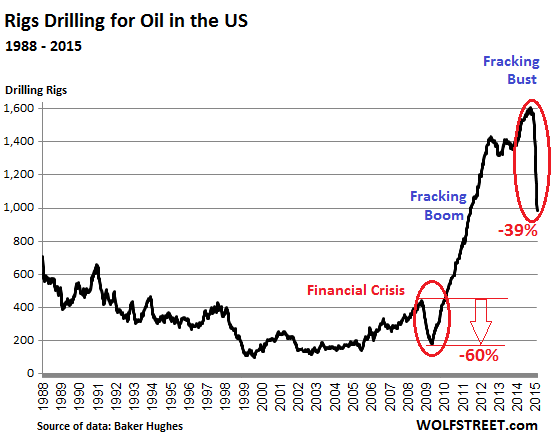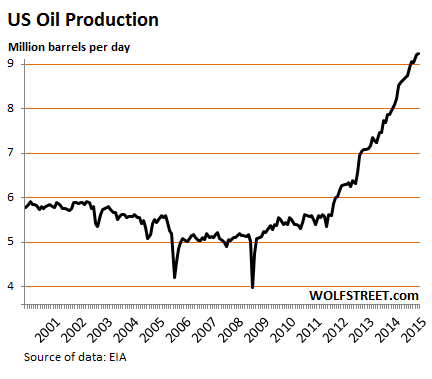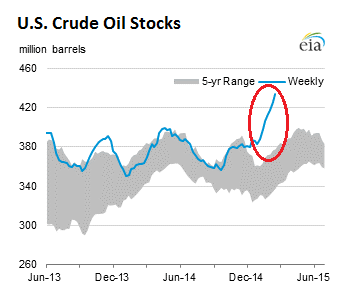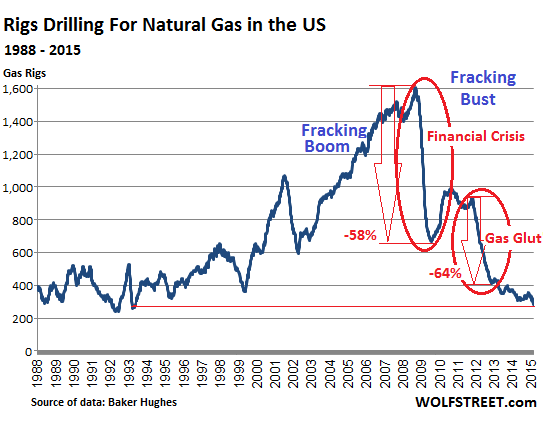Breath-taking booms and obliterating busts have made the oil and gas business. Booms draw money, which begets more money, which allows for technologies to be invented or perfected, and it builds enthusiasm that turns into blind faith among investors, and they throw more money at it. The money gets drilled into the ground. The debt remains on the balance sheet. Production soars. Demand doesn’t keep up. Storage levels rise. The price begins to plunge. And all heck breaks loose.
The fracking bust didn’t start last summer when the price of oil began to skid. It started in October and has progressed with phenomenal rapidity. In the latest week, according to Baker Hughes, which publishes the data every Friday, drillers idled an additional 33 oil rigs. Only 986 rigs were still active, down 38.7% from October, when they’d peaked at 1,609. In a period of 20 weeks, drillers have cut the number of rigs drilling for oil by 623, the steepest, deepest rig-count nose dive in the data series:
The result should be lower oil production.
But it’s not. That mountain of debt the oil and gas industry has piled up during the fracking boom needs to be serviced even though revenues are crashing as a function of the price of oil. So they cut operating costs and capital expenditures. And they’re concentrating their remaining resources on the most productive plays and the most efficient technologies to maintain some sort of survivable cash flow.
Because they’re all doing it, US production continues to soar, after a mind-bending 84% increase from about 5 million barrels per day in 2008 to over 9.2 million barrels per day in January 2015. This is what a real and ongoing boom looks like:
But demand is not keeping up, and crude oil inventories keep pushing deeper into record levels in the US. Excluding the Strategic Petroleum Reserve, crude oil stocks rose by another 8.4 million barrels to 434.1 million barrels in the latest reporting week, the highest level in the data series going back to 1982, according to the Energy Information Administration. Crude oil inventory levels were 71.7 million barrels, or 20%, higher than at the same time last year. The upward surge in crude oil inventories (blue line) defies the 5-year range (gray area):
Drillers also idled 9 rigs drilling for natural gas, which brought the gas rig count down to 280, the lowest since May 1993, and down 81% from its peak in 2008. Despite the evisceration of drilling activities, production has continued to surge over the years to new records and has turned the US into the largest natural gas producer in the world. This is what the conundrum looks like:
But take the rig-count split between oil and natural gas with a grain of salt. Whether a rig is drilling for oil or gas is a distinction made by the driller. Most fracked wells produce a variety of hydrocarbons, depending on the shale formation. A well might produce a mix of oil, natural gasoline, natural gas, and natural gas liquids like propane or butane. In theory, the driller would classify the rig based on the dominant hydrocarbon.
But in 2011-2012, the price of natural gas was plunging, while the price of oil had soared. So drillers began classifying rigs as “oil rigs” that they’d previously classified as “gas rigs” because it looked a heck of a lot better in their investor presentations. Fracking for oil was making money at those prices; but fracking for gas, at the prices prevailing at the time and still prevailing today, was an exercise in self-bleeding regardless of how drillers tried to twist it.
If investors had known reality, or had wanted to know reality, they might not have forked over that money that has now been drilled into the ground. But drillers on the dreadful fracking treadmill constantly need new money to drill more to make up for the sharp decline rates of the wells they’d just drilled. Hence their efforts at the time to beautify their wells by calling them “oil wells” even if they were getting more gas than oil. Almost nothing in the world of fracking is quite what it appears to be at first blush.
Dropping gasoline prices have perked up American consumers. After years of post-financial-crisis struggles, they finally see some light at the end of the tunnel. But suddenly, it all starts to crumble again. Read… What the Heck Has Suddenly Hit American Consumers?
Enjoy reading WOLF STREET and want to support it? You can donate. I appreciate it immensely. Click on the beer and iced-tea mug to find out how:
Would you like to be notified via email when WOLF STREET publishes a new article? Sign up here.
![]()






One comment that I have yet to see and one that for me at least, represents a far bigger threat to any muppet who invested , is the ration of leveraged debt to current wells.
That debt, no matter how you dress i up and try to smear it across a whole plethora of mostly fictitious or simply ignoring utterly bleeding activities, or discount or remove any decommissioning costs, such as redundancy payments, asset protection measures, after ll you cant just abandon a rig and simply leave it out of all the equations, there has to some efforts to preserve the capital costs, even if its for future sale of either the bankrupt company to simply to to use as an additional accounting fiction to dd to the balance sheet,
BUT whatever the bottom line is and will remain the overall total debt divided by the number of productive and active rigs and the and the value of that debt is inversely proportional to the future cash flow generation minus the operating costs and the expected future reduction in rigs
You can also include the depreciation and include the expected LOSSES, by bringing onstream current rigs in the pipeline that will increase met production, ( as the net rig count is rigs taken out and adding new rigs that are more efficient being brought onstream) but are capable of pumping oil and therefore losses at a an ever greater rate.
By my best estimates, and I don’t have all the numbers to validate it, but I am sure there are some experts out there who can take all the above in a more detailed consideration, but I think currently debt even at its current level is more than 2.5 times overvalued.
You have to very brave indeed if you own any oil debt of any description.
A good example of what happens to fracking debt is Samson Resources, owned by PE firms, led by KKR. It has now hired a “restructuring” firm. Which means it is trying to do a prepackaged bankruptcy. Equity holders will get nothing (KKR has already written down its equity investment by 95%). The company will be handed to the creditors (they’ll get the assets). The low end of the creditor totem pole will get nothing or next to nothing. Samson has been fracking mostly for natural gas, whose price has plunged years ago. But these things take time.
At the investment firm where I work in Canada, just yesterday a syndicated debt issue rolled in from one of the smallest tier 1 banks in Canada. Paying 7% plus a 4% commission, a very juicy offer for a bank.
I looked them up, they’re heavy into real estate and energy, both of which are in trouble now. When banks have to pay these kind of rates to get money, you know problems are brewing. They aren’t a big bank mind you, but it always starts with the weakest links.
If there is a drop in oil production due to the cheap price, it’ll take several months before we will know. It doesn’t happen overnight. I generally enjoy this site very much, but the articles about oil seem off from other things I’ve read.
So why has production of natural gas not dropped, though it has traded below the cost of production at most wells for years? Companies like Samson Resources will go bankrupt before they cut production. They cannot afford to cut production. They have too much debt. Decline rates of fracked wells are such that drillers have to drill just to maintain a survivable cash flow. It’s a terrible catch-22 for these companies.
So for now, they’re focused on efficiencies – getting the most production for less.
Eventually production might decline, but not nearly as soon as people expect.
There is a lot of hope out there that this oil bust will be over in a few months. The last real oil bust (not the Financial Crisis) I went through lasted years! And it took down with it 700 banks.
Excellent article. With companies continuing to focus on their most reliable production wells oil production should eventually decline since the shale generally has a production shelf life of less than 5 years, don’t you think?
So without new drilling and eventually the most profitable will decay, supply should abate.
Finally, although these companies can ramp up easily if oil prices rises, but if it’s capital intensive and many will file BK or be in distress wouldn’t lenders be reluctant to provide lending given a bust that’s looming or after one occurs?
I do enjoy your articles and thoughtful analysis into these topics.
Fracking was always a bad idea. Pumping toxic wastes back into the ground. When a well pipe becomes brittle and cracks due to chemical contamination or from back pressure of the fracking process, toxic chemicals are leached into the water supply. As a result of the greed of Oil and Gas companies around the world, I applaud the demise of the greedy and the selfish. They are their own worst enemies. When they go bankrupt, let them eat their own oil and drink their own contaminated water from their ponds.
The gas and oil industry has done what environmentalists could not, they killed the brown (not golden) goose. The death spiral of the industry has only begun and oil and natural gas prices will continue to decline. Oil should reach $25 per barrel in 2015, closing all but the largest companies- suckers!
This lesson should be learned by every oil and gas worker- “You don’t mess with Mother Nature.”
And by the way, after all the toxic waste lawsuits are finished, and the Superfund cleanups are ordered for well rigs, few of the largest will survive. The beginning of the end for big oil (notice the small letters), has begun. Thank you for doing my job for me.
The Winkle Institute for Worldwide Economic Stability
Fin., Env., Legal, Human Rights Consulting to 38 countries and the world.
“Making the world a better place to live for everyone to live.”